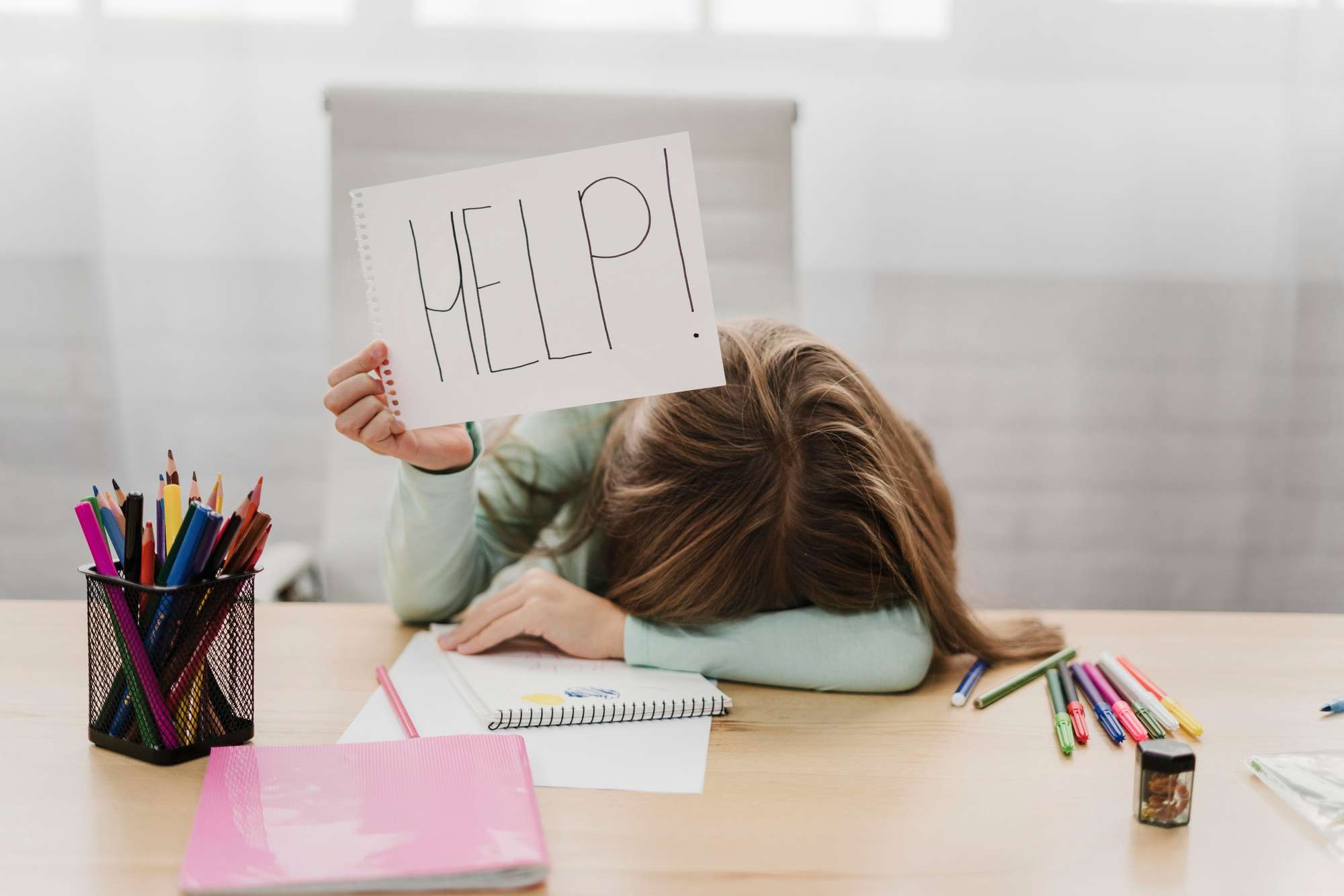
Identify signs of anxiety disorders in children by paying attention to their behaviors and emotional patterns. Are you ever puzzled by your child’s frequent worries or behaviors, questioning whether they’re typical or indicative of a deeper issue? It’s natural for children to experience anxiety occasionally, but distinguishing between normal nervousness and an anxiety disorder can be tough for any parent. You might wonder whether you’re just being overly cautious or if your child genuinely needs professional intervention. The surrounding stigma concerning mental health issues could also make you reluctant to seek help, compounded by doubts about the efficacy of recommended strategies. Additionally, juggling a hectic schedule with scarce resources might make the task of finding suitable support seem daunting.
Table of Contents
ToggleHowever, this blog aims to alleviate those concerns by helping you to recognizing and treating child anxiety understand the underlying causes, and discover effective coping strategies for child anxiety. By the end of this guide, you’ll have a clearer perspective on recognizing anxiety symptoms in your child and the necessary actions to support their well-being. Let’s embark on this crucial journey together. If you’re concerned about your child’s anxiety, don’t worry. Call our top psychologist now for expert help!
Symptoms and Signs of Anxiety Disorders in Children
To effectively identify signs of panic disorders in children, parents need to be aware of the subtle and complex nature of anxiety symptoms, as they often differ significantly among individuals. Here are key signs and symptoms to watch for:
Behavioral Signs
- Avoidance: Children experiencing anxiety may dodge situations or activities that induce stress, such as attending school, participating in social events, or engaging in new experiences.
- Tantrums: Particularly in younger children, tantrums may occur in response to situations that evoke anxiety, serving as an outlet for their intense emotions.
- Seeking Reassurance: It’s common for anxious children to need continual reassurance, asking questions like “Is everything going to be alright?” or “Are we sure it’s safe?”
Physical Symptoms
- Stomachaches: Often, anxiety manifests physically, with recurrent stomachaches being a frequent symptom, particularly before school or social interactions.
- Headaches: Unexplained headaches can also be a symptom of anxiety in children, with no apparent physical cause.
- Fatigue: The exhaustive nature of anxiety might lead to pronounced tiredness, sleep disturbances, or nightmares, affecting overall sleep quality.
Emotional Indicators
- Excessive Worry: A hallmark of anxiety is excessive worry about ordinary concerns, such as health, family safety, or academic performance.
- Irritability: Anxious children may often seem on edge, exhibiting mood swings, easy frustration, or increased crying.
- Crying: More frequent and easily triggered crying is common among children with anxiety, which can be a release for their accumulated stress.
By focusing on these symptoms, you can better identify signs of panic disorders in children and take steps toward helping them manage their anxiety.
If you’re concerned about your child’s anxiety, don’t worry. Call our top psychologist now for expert help!
Academic and Social Impact: How to Identify signs of anxiety conditions in children
Understanding the broader impact of anxiety is essential when you identify signs of anxiety conditions in children. Anxiety can significantly affect various aspects of a child’s life:
- Decline in School Performance: Anxiety can impair a child’s ability to focus, which may lead to worsened academic performance, struggles with homework, inattentiveness in class, or reluctance to engage in school activities.
- Social Withdrawal: An anxious child might begin to pull back from previously enjoyed social interactions, avoiding events like playdates, extracurricular activities, or family functions. This can be a sign of increasing anxiety, which makes it crucial to identify signs of anxiety conditions in children early on.
Causes and Risk Factors: What to Know When You Identify signs of anxiety disorders in children
Understanding the causes and risk factors that contribute to nervous conditions is crucial when trying to identify signs of anxiety syndrome in children. While the exact causes of anxiety conditions are not fully understood, several factors can contribute to their development.
Genetic Predisposition
Research suggests a hereditary component to anxiety, indicating that they may be more prevalent in children whose parents or close kin have faced similar challenges. This genetic propensity highlights a predisposition that some children might have toward developing anxiety from a young age. Parents who understand this background can better these signs and seek help when needed.
Environmental Factors
A child’s surroundings play a crucial role in shaping their emotional health. Factors that can heighten anxiety include:
- Family Dynamics: Stressful family settings, marked by frequent conflicts or unstable routines, can heighten anxiety levels in children. Consistency and calmness at home are essential in fostering a secure environment. Parents in such situations may need to pay extra attention to identify signs of anxiety in children.
- Life Events: Traumatic experiences such as the demise of a close one, parental separation, or experiencing a disaster can profoundly impact a child, potentially triggering anxiety. These significant incidents can instill a sense of insecurity and continuous worry in young minds.
Psychological Factors: Helping to Identify signs of anxiety fear in children
Individual psychological characteristics may also influence the likelihood of developing mental anxiety :
- Natural Disposition: Naturally sensitive or cautious children might be more vulnerable to anxiety.
- Coping Mechanisms: A lack of effective coping strategies for child anxiety can leave children ill-prepared to handle stress and adversity effectively.
Parents can recognize signs of anxiety in children more easily by closely monitoring these symptoms and factors over time.
The Role of Parents in Helping to Identify signs of anxiety syndrome in children
Parents’ handling of anxiety can significantly affect their children. Young ones frequently take emotional cues from their parents. An anxious or overly protective parent might inadvertently teach their child to perceive the world as fraught with danger, potentially leading to heightened anxiety. Conversely, parents who manage their stress well and demonstrate effective methods for managing child anxiety can foster resilience in their children.
If you’re concerned about your child’s anxiety, don’t worry. Call our top psychologist now for expert help!

Effective Coping Strategies for Parents and Children
When a child experiences anxiety, parents have several tools at their disposal to aid their coping and improve their well-being. Below are some coping strategies for kids with anxiety:
Communication Strategies
- Open Conversations: Motivate your child to express their feelings. Reassure them that it’s normal to feel anxious and that you’re available to listen and help. Pose questions that encourage discussion, such as, “Can you share how you’re feeling?” or “What thoughts have been on your mind?”
- Engaged Listening: Demonstrate your engagement by maintaining eye contact, nodding, and summarizing their words. This validation can make them feel valued and supported.
Building a Supportive Environment
- Consistent Schedules: A regular daily schedule can create a reassuring environment for children with anxiety. Set predictable times for eating, doing homework, and sleeping. These routines can help parents identify signs of anxiety syndrome in children by noting deviations in behavior when routines are disrupted.
- Positive Feedback: Acknowledge your child’s efforts to handle their anxiety. Celebrate even minor achievements to boost their self-esteem and encourage positive behavior.
Teaching Relaxation Techniques
- Guided Breathing Exercises: Introduce your child to controlled breathing techniques to help soothe their nervous system. Practice inhaling through the nose, pausing, and exhaling slowly through the mouth together.
- Mindfulness Practices: Promote activities that focus on the present moment, such as savoring the flavors of a meal or feeling the texture of an object. These practices can help center and calm their mind.
- Progressive Muscle Relaxation: Teach them to gradually tense and relax muscle groups. This technique can alleviate physical stress and foster relaxation.
Encouraging Physical Activity and Healthy Lifestyle Habits
- Encouraging Exercise: Regular physical activity can alleviate symptoms of anxiety and elevate mood. Support your child in finding enjoyable physical activities like sports or playful outdoor games.When a child experiences anxiety, parents have several tools at their disposal to aid their coping and improve their well-being. Below are some coping strategies for kids with anxiety:
Communication Strategies
- Open Conversations: Motivate your child to express their feelings. Reassure them that it’s normal to feel anxious and that you’re available to listen and help. Pose questions that encourage discussion, such as, “Can you share how you’re feeling?” or “What thoughts have been on your mind?”
- Engaged Listening: Demonstrate your engagement by maintaining eye contact, nodding, and summarizing their words. This validation can make them feel valued and supported.
Building a Supportive Environment
- Consistent Schedules: A regular daily schedule can create a reassuring environment for children with anxiety. Set predictable times for eating, doing homework, and sleeping.
- Positive Feedback: Acknowledge your child’s efforts to handle their anxiety. Celebrate even minor achievements to boost their self-esteem and encourage positive behavior.
Teaching Relaxation Techniques
- Guided Breathing Exercises: Introduce your child to controlled breathing techniques to help soothe their nervous system. Practice inhaling through the nose, pausing, and exhaling slowly through the mouth together.
- Mindfulness Practices: Promote activities that focus on the present moment, such as savoring the flavors of a meal or feeling the texture of an object. These practices can help center and calm their mind.
- Progressive Muscle Relaxation: Teach them to gradually tense and relax muscle groups. This technique can alleviate physical stress and foster relaxation.
Encouraging Physical Activity and Healthy Lifestyle Habits
- Encouraging Exercise: Regular physical activity can alleviate symptoms of anxiety and elevate mood. Support your child in finding enjoyable physical activities like sports or playful outdoor games.
- Nutritional Balance: Emphasize the importance of a nutritious diet rich in fruits, vegetables, and whole grains to support mental and physical health.
- Sleep Routines: Establish a regular sleep schedule and a serene bedtime routine. Reducing screen time before bed can also enhance sleep quality.
Professional Help and Therapy Options
Understanding when professional intervention is necessary is vital when you identify signs of anxiety syndrome in children:
- Cognitive Behavioral Therapy (CBT): CBT is an effective treatment for anxiety, helping children alter negative thoughts and behaviors linked to their anxiety.
- Counseling Services: Consider counseling for your child or the family to facilitate emotional expression and coping strategy development.
By consistently practicing these strategies, you can effectively identify signs of anxiety disorders in children and support them in managing their symptoms.
When to Seek Professional Help
Sometimes, despite your best efforts, your child may need additional support from a professional. Here are some signs that it might be time to seek help from a mental health professional:
- Persistent Anxiety: If anxiety continues extensively and disrupts everyday activities, professional help may be necessary.
- Disruption in Daily Activities: When anxiety hinders school attendance or social participation, it might be time to consult a mental health professional.
- Signs of Severe Distress: If your child displays severe distress or mentions self-harm, immediate professional intervention is crucial.
Mental health professionals, such as psychologists, psychiatrists, and licensed counsellors, can provide specialised care and treatment tailored to your child’s needs. They can work with you and your child to develop an effective treatment plan, which may include therapy, medication, or a combination of both.
Conclusion
By learning to identify signs of anxiety fear in children and addressing them early on, parents can implement anxiety management techniques for children to foster their well-being. Remember, numerous resources and experts are available to support both you and your child.
